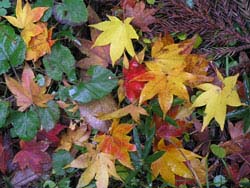Quick Digs: Putting Salvias to Bed with Winter Mulch

During spring, a heavy coat of fall leaves or wood mulch isn't good for Salvias, because it can cause fungal problems that attack crown and roots. But in winter, organic mulches are ideal for blanketing the foliage and root area of sages.
Mulch is particularly useful in protecting protect plant roots against injury from freeze-and-thaw cycles, especially for new fall plantings. This is the second article in our Quick Digs series on preparation for winter in the Salvia garden, which began with this post.
Let's say you live in USDA Cold Hardiness Zone 6 and have recently planted some Zone 5 or 6 Autumn Sage (Salvia greggii spp.) that are now about 18 inches tall and wide. However, you are worried that the plant roots aren't established enough to avoid heaving out of the ground when it freezes.
When ground thaws, heaved roots don't always sink back into the ground with the shrinking soil. Often, they are exposed to dry, cold air as well as more freeze-thaw cycles. One way to minimize this problem is to apply a thick blanket of leafy mulch on the soil around each plant. Remove the mulch in spring when threat of frost has passed. This is especially important for protecting new plantings.
But what do you do if you have a flowerbed filled with beautiful sages that are perennial to warmer zones and which you don't want to dig up each year to overwinter indoors?
Creating a Mulch Comforter
Here is an innovative idea from a gardener who tired of losing favorite plants, such as Mexican Sage (Salvia Darcyi) and Cedar Sage (Salvia roemeriana) to harsh winter weather. We pay close attention to horticultural professionals, but also encounter excellent ideas on gardening social-media sites. For example, the Hummingbird Forum is a great place to chat with experienced Salvia gardeners, such as a Minnesotan who manages to keep Zone 7 plants alive through Zone 4 winters.
Normally, we don't recommend hard pruning of sage in autumn, but this method requires it. It also requires a raised-bed planter amended with sand for excellent drainage, because damp roots are dangerous for sages in freezing weather.
Here is how the Minnesota gardener puts his Salvias and companion plants to bed for the winter:
- Wait until hard frost kills foliage and then cut back your plants to a few inches above ground.
- Fill enough sturdy garbage bags with dry leaves to completely cover the flowerbed two bags deep.
- Cover the garbage-bag layer with a tarp weighted down at the edges with heavy objects.
- Leave snow on the tarp, because it's a natural insulator.
- Uncover the flowerbed in spring after threat of frost has passed and check for new growth.
- Don't expect all the plants to survive; celebrate the ones that do.
Quick Digs and Questions
Each Quick Digs series selects a central issue about gardening and provides a series of brief articles suggesting ways to deal with the issue. The third article in this series about preparation for winter in the Salvia garden concerns overwintering sages in containers outdoors.
Another way to deal with questions about winter preparation is to contact us. We can't offer any works-every-time solutions, but we are glad to share ideas.
Please Note: When we first published this article in 2013, we suggested a mulch tower procedure -- tomato cages stuffed with autumn leaves and surrounded with ventilated plastic trash bags -- for protecting individual plantings in areas where snow is prevalent and freeze-thaw cycles cause roots to heave. We've since decided that a heavy blanket of leaves around the base of these plants is sufficient.

 Salvia roemeriana
Salvia roemeriana  Salvia darcyi 'Pscarl'
Salvia darcyi 'Pscarl'
Comments
There are no comments yet.